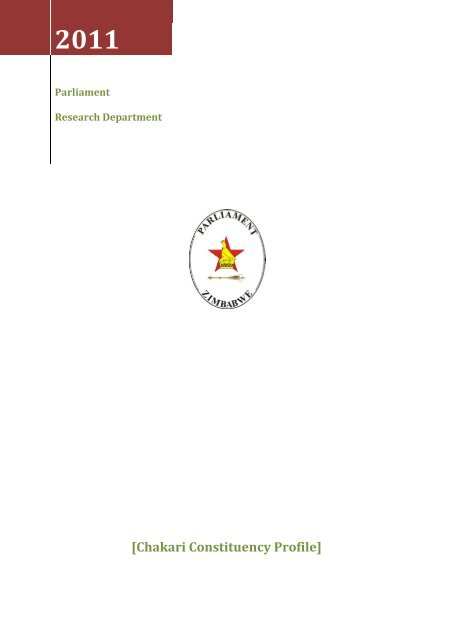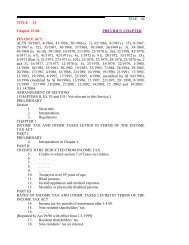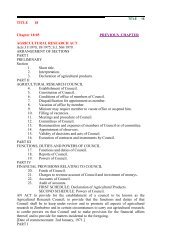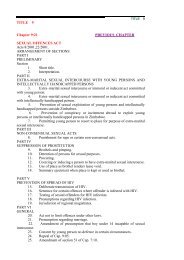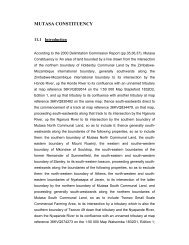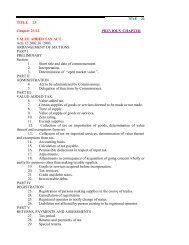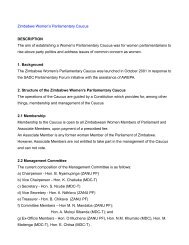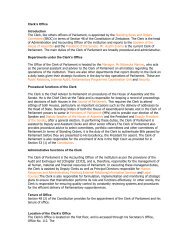Chakari Constituency Profile - Zimbabwe Parliament
Chakari Constituency Profile - Zimbabwe Parliament
Chakari Constituency Profile - Zimbabwe Parliament
You also want an ePaper? Increase the reach of your titles
YUMPU automatically turns print PDFs into web optimized ePapers that Google loves.
2011<br />
<strong>Parliament</strong><br />
Research Department<br />
[<strong>Chakari</strong> <strong>Constituency</strong> <strong>Profile</strong>]
Table of Contents<br />
1.0 Introduction ..................................................................................................................................................... 3<br />
2.0 Population distribution ............................................................................................................................... 3<br />
3.0 Education .......................................................................................................................................................... 4<br />
3.1 Primary Education ......................................................................................................................................... 4<br />
3.2 Secondary Schools ......................................................................................................................................... 6<br />
3.0 Health .................................................................................................................................................................. 7<br />
5.0 Animal Health .................................................................................................................................................. 7<br />
6.0 NGOs .................................................................................................................................................................... 8<br />
7.0 Business Centres and Rural Electrification ......................................................................................... 8<br />
8.0 Local Government .......................................................................................................................................... 9<br />
9.0 Conclusions....................................................................................................................................................... 9<br />
10.0 Recommendations ......................................................................................................................................... 9<br />
Bibliography ............................................................................................................................................................... 11<br />
List of Figures<br />
Figure 1: Population Distribution by Wards ......................................................................................................... 3<br />
Figure 2: Comparison of Population and Registered Voters .......................................................................... 4<br />
Figure 3: Primary School Enrolment by Ward ..................................................................................................... 5<br />
Figure 4: Secondary School Enrolment by School .............................................................................................. 6<br />
List of Tables<br />
Table 1: Primary School Statistics ............................................................................................................................. 5<br />
Table 2: Secondary School Statistics ........................................................................................................................ 6<br />
Table 3: Health Facilities in the <strong>Constituency</strong> ...................................................................................................... 7<br />
Table 4: Dip Tanks and Cattle Census by Ward ................................................................................................... 7<br />
Table 5: NGOs Operating in the <strong>Constituency</strong> ...................................................................................................... 8<br />
Table 6: Business Centres in the constituency ..................................................................................................... 8<br />
Table 7: Councilors and Social Infrastructure ...................................................................................................... 9<br />
<strong>Chakari</strong> <strong>Constituency</strong> <strong>Profile</strong> Page 2
Population<br />
1.0 Introduction<br />
<strong>Chakari</strong> is a new constituency which was cut from Old Kadoma West <strong>Constituency</strong>. It<br />
comprises of <strong>Chakari</strong>, Pat Cowden Valley, Perseverance and Chigaro. It is made up of 6<br />
wards i.e. 1-5 and 7. The constituency's livelihood was largely dependent on commercial<br />
farms and gold mines which have since been unproductive hence contributing to the people's<br />
economic hardships. Illegal gold mining is on the rise with the influx of people into the<br />
constituency (ZESN Report, pp 63).<br />
2.0 Population distribution<br />
The total population of <strong>Chakari</strong> <strong>Constituency</strong> is 21 692 and only 21639 are registered voters,<br />
representing about 99% of the total population. There are 10 128 males and 11 564 females<br />
representing about 47% and 53% of total population respectively. There are 4 955 households<br />
with an average household size of 4 people per household. In the constituency, all wards have<br />
more females than males. See figure 1 below.<br />
Population Distribution<br />
6000<br />
5000<br />
4000<br />
3000<br />
2000<br />
Male<br />
Female<br />
Popn. 2002<br />
1000<br />
0<br />
1 2 3 4 5 7<br />
Wards<br />
Figure 1: Population Distribution by Wards<br />
<strong>Chakari</strong> <strong>Constituency</strong> <strong>Profile</strong> Page 3
Ward 4 has the highest population followed by ward 5, 1 and 3 respectively. The least<br />
population is found in ward 7 with less than 2000 people.<br />
2.1 Voter Population<br />
Registered voters constitute about 99% of the total constituency population. Figure 2 below<br />
show the relative number of voters to the total population. There are discrepancies on the<br />
information provided on population against registered voters, e.g. wards 3, 1 and 2 have more<br />
registered voters compared to population.<br />
Figure 2: Comparison of Population and Registered Voters<br />
3.0 Education<br />
3.1 Primary Education<br />
<strong>Chakari</strong> <strong>Constituency</strong> has 31 primary schools with a total of 12 984 pupils enrolled as at<br />
December 2010. Out of this total, 6 677 are boys and 6 307 are girls, representing 51% and<br />
49% respectively. Most pupils are found in wards 2, 4 and 5 while wards 1 and 7 have the<br />
least number of pupils. The table below refers.<br />
<strong>Chakari</strong> <strong>Constituency</strong> <strong>Profile</strong> Page 4
Pupils<br />
Primary School Enrolment<br />
6000<br />
5000<br />
4000<br />
3000<br />
2000<br />
1000<br />
Boys<br />
Girls<br />
Total<br />
0<br />
1 2 3 4 5 7<br />
Ward<br />
Figure 3: Primary School Enrolment by Ward<br />
The average teacher/pupil ratio in all the wards ranges between 32:1 and 43:1 with ward 4<br />
having the lowest ratio of 20:1. The desired ratio set out in the 2015 MDGs goals is 28:1, thus<br />
the district has a long way to go in terms of attracting trained teachers in other wards which<br />
exceeds the MDG target. The whole constituency has 407 trained teachers with 173 (43%)<br />
being male and 234 (57%) being females.<br />
Table 1: Primary School Statistics<br />
War Boys Girls Total Male Female Total Teacher/Pupil<br />
d<br />
Teachers Teachers Teachers Ratio<br />
1 304 292 596 9 5 14 1:43<br />
2 2465 2417 4882 53 84 137 1:36<br />
3 885 759 1644 31 51 82 1:20<br />
4 1426 1397 2823 42 43 85 1:32<br />
5 1468 1312 2780 33 49 82 1:34<br />
7 129 130 259 5 2 7 1:37<br />
Total 6677 6307 12984 173 234 407 1:32<br />
<strong>Chakari</strong> <strong>Constituency</strong> <strong>Profile</strong> Page 5
Ward<br />
School<br />
Name<br />
Date Est.<br />
Boys<br />
Girls<br />
Total<br />
Authority<br />
Level<br />
Mode of<br />
Operation<br />
Male Trs<br />
Female<br />
Trs<br />
Students<br />
3.2 Secondary Schools<br />
<strong>Chakari</strong> <strong>Constituency</strong> has 4 secondary schools, all owned by Rural District Council. There is<br />
no 'A' Level secondary school in the <strong>Constituency</strong>. The combined enrolment in the<br />
constituency stands at 692 students comprising of 289 boys and 403 girls constituting 42%<br />
and 58% respectively. Mususe Secondary School has the highest enrolment ratio (193)<br />
followed by Tawnstock School, while Muzvezve has the least number of students. All the<br />
schools are found in Ward 2 and 4 only. Of importance to note also is that more girls attend<br />
Secondary School Enrolment<br />
250<br />
200<br />
150<br />
100<br />
Boys<br />
Girls<br />
Total<br />
50<br />
0<br />
Mususe Muzvezve Tagarika Taw nstock<br />
School Name<br />
Figure 4: Secondary School Enrolment by School<br />
secondary school in the constituency compared to boys.<br />
There are 29 teachers of which 19 are trained teachers. Of the 29 teachers, 24 are males and 5<br />
are females. The average teacher and student ratio is 1:19.<br />
Table 2: Secondary School Statistics<br />
2 Mususe 98 95 193 RDC “O” Level Day 9 8<br />
2 Muzvezve 1998 39 30 69 RDC “O” Level 5 4<br />
4 Tagarika 2002 71 69 140 RDC “O” Level Day 8 5<br />
4 Tawnstock 2002 81 70 151 RDC “O” Level Day 7 7<br />
<strong>Chakari</strong> <strong>Constituency</strong> <strong>Profile</strong> Page 6
Ward<br />
Centre<br />
Name<br />
Communi<br />
cations<br />
Fire<br />
Protection<br />
Hospital<br />
Equipmen<br />
t<br />
Maternity<br />
Beds<br />
Status<br />
Authority<br />
Doctors<br />
Nurses<br />
Nurse<br />
Aides<br />
The table indicates that most of the schools were built way after independence around 1998<br />
and 2002. There is no 'A' Level School in the <strong>Constituency</strong>.<br />
3.0 Health<br />
There are 2 clinics in <strong>Chakari</strong> <strong>Constituency</strong> found in wards 1 and 5 only. One of the clinics is<br />
owned by the rural district council while the other is unknown. All the clinics do not have<br />
the basic infrastructure and equipment to enable them to operate effectively. See Table 3<br />
below.<br />
Table 3: Health Facilities in the <strong>Constituency</strong><br />
1 Ngezi No No No No Clinic - - -<br />
5 Ingezi No No No No Clinic RDC - -<br />
5.0 Animal Health<br />
There are 51069 cattle in <strong>Chakari</strong> <strong>Constituency</strong> with 24 dips available to serve the whole<br />
constituency. Most of the cattle are found in wards 2 followed by 5 and 3 all with 8, 6 and 4<br />
dip tanks respectively. Ward 2 has the least cattle with only 2 dip tanks. The information<br />
regarding the functionality of the dip tanks was not available. The distribution of the facilities<br />
is shown in the Table 4 below.<br />
Table 4: Dip Tanks and Cattle Census by Ward<br />
Ward Dips Cattle<br />
1 2 3078<br />
2 8 5915<br />
3 4 4093<br />
4 2 1750<br />
5 6 4919<br />
<strong>Chakari</strong> <strong>Constituency</strong> <strong>Profile</strong> Page 7
7 2 3134<br />
Total 24 51069<br />
6.0 NGOs<br />
The NGOs operate in conjunction with the civil society to bring about coordinated response<br />
to areas of concern to the public. In <strong>Chakari</strong> District, there are about 2 NGOs which<br />
specialize on Humanitarian Aid, covering mostly HIV/AIDS, education and health.<br />
Table 5: NGOs Operating in the <strong>Constituency</strong><br />
NGO Ward Name Field of Operation<br />
Batsirai Group 1 – 7 HIV/AIDs Counseling and Testing, Behaviour<br />
Change<br />
Environment<br />
Africa<br />
1 – 7 Water and Sanitation, Nutrition Gardens and Green<br />
Schools Programme<br />
7.0 Business Centres and Rural Electrification<br />
There are 6 business centres in <strong>Chakari</strong> <strong>Constituency</strong> with none with a growth point status. In<br />
terms of facilities, all business centres do not have electricity, GMB/CMB, police posts and<br />
banks. There is only 1 post office in the constituency found at <strong>Chakari</strong> Business Centre.<br />
Other facilities found in the constituency include 15 grinding mills found in wards 1, 3, 4 and<br />
5, 2 bakeries and 2 butcheries at <strong>Chakari</strong> BC. For more details refer to Table below.<br />
Table 6: Business Centres in the constituency<br />
Ward Centre Name Status Electrified Police Clinic/H<br />
centre<br />
Post<br />
Office<br />
GMB<br />
deport<br />
CMB<br />
Deport<br />
1 Blue Grass BC No No 1 No No No<br />
2 Golden Valley BC No No No No No No<br />
3 <strong>Chakari</strong> BC No No No Yes No No<br />
4 Brompton BC No No No No No No<br />
5 Vere BC No No 1 No No No<br />
7 Chegutu Six BC No No No No No No<br />
<strong>Chakari</strong> <strong>Constituency</strong> <strong>Profile</strong> Page 8
8.0 Local Government<br />
<strong>Chakari</strong> constituency has 6 wards, 1 – 6 and 7. All the wards have councilors and in terms of<br />
gender representation there are 3 males and 3 females. There are 41 crèches, 24 dip tanks and<br />
2 clinics available in the constituency. For further details, see table below.<br />
Table 7: Councilors and Social Infrastructure<br />
Ward Councillor M/F Crèche Pry Sec Tertiary Clinics Dip Tank<br />
Sch Sch<br />
1 Muchemenyi A F 3 3 1 1 1 2<br />
2 Karadu M 8 7 2 0 8<br />
3 Mulambilila F 9 6 1 0 4<br />
4 Mazorodze F 4 3 2 0 2<br />
5 Muchineripi M 17 7 1 1 6<br />
7 Zuze M 6 4 1 0 2<br />
9.0 Conclusions<br />
<strong>Chakari</strong> is a rural constituency whose livelihood is mainly depended on commercial farming<br />
and illegal gold mining. Due to gold mining activities that take place within the constituency,<br />
the cost of living has become expensive for many people in the area. In the education sector,<br />
the primary schools have an average pupil to teacher ratio of 32:1 which is lower than the<br />
National average of 43:1. The MDG report states that this ratio varies according to type of<br />
school ranging from 36:1 in privileged primary schools to 52:1 in poor rural schools. (2010<br />
MDG Status Report <strong>Zimbabwe</strong>, 2010). Electrification is also a challenge as all business<br />
centres do not have electricity. The constituency has 6 business centres. There are 2 NGOs in<br />
the area specialising in Humanitarian aid probably due to the vulnerability of constituency to<br />
HIV/AIDS.<br />
10.0 Recommendations<br />
With regards to electricity, the rural electrification project should be reinvigorated to<br />
cover all centres and institution in the constituency.<br />
<strong>Chakari</strong> <strong>Constituency</strong> <strong>Profile</strong> Page 9
With regard to education, more programmes should be initiated to achieve better<br />
transition ratios from primary to secondary level education as well as attracting<br />
qualified teachers.<br />
<strong>Chakari</strong> <strong>Constituency</strong> <strong>Profile</strong> Page 10
Bibliography<br />
1. Central Statistical Office (CSO), 2002. Census 2002 <strong>Zimbabwe</strong> Preliminary Report,<br />
Government of <strong>Zimbabwe</strong>, Harare<br />
2. Government of <strong>Zimbabwe</strong>, 2006. <strong>Zimbabwe</strong> 2003 Poverty Assessment Study Survey<br />
Summary (PASS) Report, Ministry of Public Service , Labour and Social Welfare,<br />
July 2006, Harare<br />
3. Government of <strong>Zimbabwe</strong>, UNDP, 2010. 2010 Millennium Development Goals<br />
Status Report, Ministry of Labour and Social Services, UNDP, Harare<br />
4. <strong>Zimbabwe</strong> Election Support Network (ZESN), 2008, A profile of Constituencies:<br />
Understanding Elections in <strong>Zimbabwe</strong>, ZESN, Harare.<br />
5. <strong>Zimbabwe</strong> Electoral Commission (ZEC), 2008. The report on the Delimitation<br />
Exercise for the 2008 Harmonised Elections, Government of <strong>Zimbabwe</strong>, Harare.<br />
6. <strong>Zimbabwe</strong> Vulnerability Assessment Committee (ZimVac), 2009 ZimVac Rural<br />
Household Livelihoods Survey Report No.11, October 2009, Harare<br />
Contact Information<br />
For Enquiries, views and comments write to:<br />
The Clerk of <strong>Parliament</strong><br />
Attn: Informatics Project Administrator<br />
<strong>Parliament</strong> of <strong>Zimbabwe</strong> Cnr. Kwame Nkurumah and 3 rd Street<br />
P.O. Box CY 298, Causeway,<br />
Harare, <strong>Zimbabwe</strong><br />
Tel: 263-4-700181-8,263-4-252936-49<br />
Fax: 263-4-252935<br />
E-mail: research@parlzim.gov.zw<br />
Website: www.parlzim.gov.zw<br />
<strong>Chakari</strong> <strong>Constituency</strong> <strong>Profile</strong> Page 11


